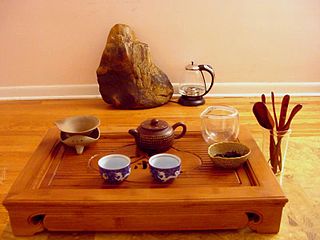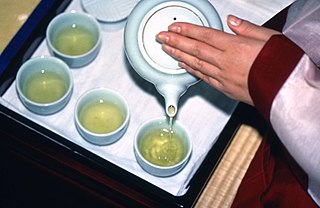
Bubble tea is a tea-based drink that originated in Taiwan in the early 1980s. It most commonly consists of tea accompanied by chewy tapioca balls, but it can be made with other toppings as well. There is a common misconception that the name "bubble tea" refers to the appearance of the pearls, but it originates from the appearance of bubbles in the milk and tea blend after it is removed from the shaking machine.

Oolong (; simplified Chinese: 乌龙; traditional Chinese: 烏龍 is a traditional semi-oxidized Chinese tea produced through a process including withering the plant under strong sun and oxidation before curling and twisting. Most oolong teas, especially those of fine quality, involve unique tea plant cultivars that are exclusively used for particular varieties. The degree of oxidation, which varies according to the chosen duration of time before firing, can range from 8 to 85%, depending on the variety and production style. Oolong is especially popular in south China and among Chinese expatriates in Southeast Asia as is the Fujian preparation process known as the Gongfu tea ceremony.

Taiwanese cuisine has several variations. In addition to dishes influenced by the majority Hoklo people, there is much influence from Taiwanese indigenous peoples, Hakka, Waishengren, local derivatives of Japanese cuisine, as well as types of Chinese cuisine from outside Fujian.

Xiamen, alternately known as Amoy, is a sub-provincial city in southeastern Fujian, People's Republic of China, beside the Taiwan Strait. It is divided into six districts: Huli, Siming, Jimei, Tong'an, Haicang, and Xiang'an. All together, these cover an area of 1,700.61 square kilometers (656.61 sq mi) with a population of 5,163,970 as of 2020 and estimated at 5.17 million as of 31 December 2020. The urbanized area of the city has spread from its original island to include most parts of all six of its districts, and with 4 Zhangzhou districts, form a built-up area of 7,284,148 inhabitants. This area is also about to connect with Quanzhou in the north, making up a future metropolis of nearly ten million people. The Kinmen Islands (Quemoy) administered by the Republic of China lie less than 6 kilometers (4 mi) away.

Japanese tea ceremony is a Japanese cultural activity involving the ceremonial preparation and presentation of matcha (抹茶), powdered green tea, the art of which is called (o)temae ([お]手前/[お]点前).

Chinese culture is one of the world's oldest cultures, originating thousands of years ago. The culture prevails across a large geographical region in East Asia and is extremely diverse and varying, with customs and traditions varying greatly between provinces, cities, and even towns as well. The terms 'China' and the geographical landmass of 'China' has shifted across the centuries, with the last name being the Great Qing before the name 'China' became commonplace in modernity.

A tea ceremony is a ritualized form of making tea practiced in East Asia by the Chinese, Koreans and Japanese. The tea ceremony, literally translated as "way of tea" in Japanese, "etiquette for tea" or "tea rite" in Korean, and "art of tea" in Chinese, is a cultural activity involving the ceremonial preparation and presentation of tea. The Japanese tea ceremony was influenced by the Chinese tea culture during ancient and medieval times, starting in the 9th century when tea was first introduced to Japan from China. One can also refer to the whole set of rituals, tools, gestures, etc. used in such ceremonies as tea culture. All of these tea ceremonies and rituals contain "an adoration of the beautiful among the sordid facts of everyday life", as well as refinement, an inner spiritual content, humility, restraint and simplicity "as all arts that partake the extraordinary, an artistic artificiality, abstractness, symbolism and formalism" to one degree or another.

Chinese tea culture refers to how tea is prepared as well as the occasions when people consume tea in China. Tea culture in China differs from that in European countries like Britain and other East and Southeast Asian countries like Japan, Korea, Vietnam in preparation, taste, and occasion when it is consumed. Tea is still consumed regularly, both on casual and formal occasions. In addition to being a popular beverage, it is used in traditional Chinese medicine as well as in Chinese cuisine.

Ikebana is the Japanese art of flower arrangement. It is also known as kadō. The tradition dates back to Heian period, when floral offerings were made at altars. Later, flower arrangements were instead used to adorn the tokonoma (alcove) of a traditional Japanese home.

Keemun is a famous Chinese black tea. First produced in the late 19th century, it quickly became popular in the West and is still used for a number of classic blends. It is a light tea with characteristic stone fruit and slightly smoky notes in the aroma and a gentle, malty, non-astringent taste reminiscent of unsweetened cocoa. Keemun is said to have floral aromas and wooden notes.
Jasmine tea is tea scented with the aroma of jasmine blossoms. Typically, jasmine tea has green tea as the tea base; however, white tea and black tea are also used. The resulting flavour of jasmine tea is subtly sweet and highly fragrant. It is the most famous scented tea in China.

The culture of Taiwan is a blend of Confucian Chinese and indigenous Taiwanese cultures. Despite the overwhelming traditional Chinese influence, Japanese culture has influenced a lot of Taiwanese culture as well. The common socio-political experience in Taiwan gradually developed into a sense of Taiwanese cultural identity and a feeling of Taiwanese cultural awareness, which has been widely debated domestically.

Korean flower arrangement is being revived as an indoor art, and most often uses simple Joseon dynasty whiteware to highlight Korean flowers and tree branches in elegant and unforced natural arrangements. Im Wha-Kong of Ewha Woman's University in Seoul, who also makes her own ceramic wares, is the greatest living exponent of this art, and hosts quarterly displays of flower arrangements keeping this tradition alive. There are at least a dozen schools of traditional flower arrangements.

Tea culture is defined by the way tea is made and consumed, by the way the people interact with tea, and by the aesthetics surrounding tea drinking.

The gongfu tea ceremony or kung fu tea ceremony, is a kind of Chinese tea ceremony, involving the ritual preparation and presentation of tea. It is probably based on the tea preparation approaches originated in Fujian and the Chaoshan area of eastern Guangdong. The term literally means "making tea with skill". The approach often involves using smaller brewing vessels and a higher leaf-to-water ratio than in western-style brewing. Today, the approach is used popularly by teashops carrying tea of Chinese origins, and by tea connoisseurs as a way to maximize the taste of a tea selection, especially a finer one.

Korean tea is a beverage consisting of boiled water infused with leaves, roots, flowers, fruits, grains, edible mushrooms, or seaweed.

Agriculture is one of the main industries in Taiwan. It contributes to the food security, rural development and conservation of Taiwan. Around 24% of Taiwan's land is used for farming. Taiwan is a global leader in vertical farming.
Bambooworking is the activity or skill of making items from bamboo, and includes architecture, carpentry, furniture and cabinetry, carving, joinery, and weaving. Its historical roots in Asia span cultures, civilizations, and millennia.
















